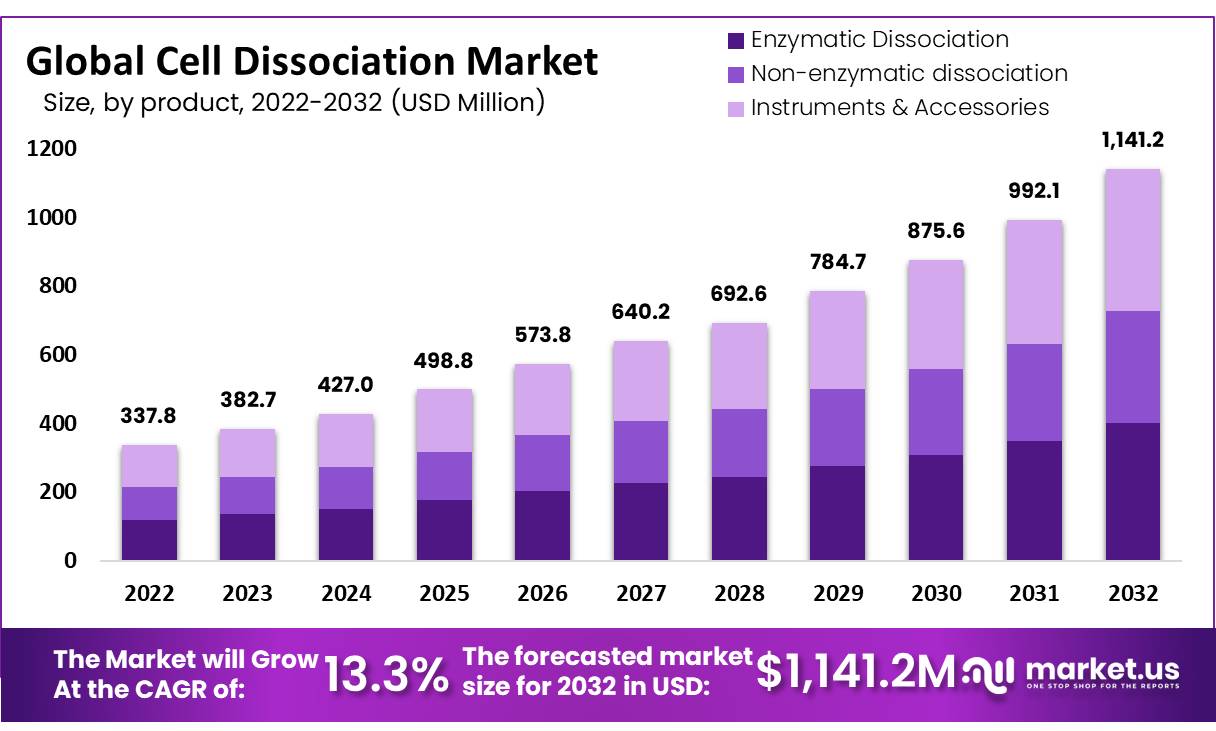Cell Dissociation Market To Develop Speedily With CAGR Of 13.3% By 2032 | According To Market.us

Page Contents
Published Via 11Press : Cell dissociation market growth will likely experience substantial acceleration due to technological advancements in cell separation techniques, the increasing demand for biopharmaceuticals, and expanding research industry. Cell dissociation involves dispersing single-cell suspensions from tissue or organ samples into single-cell suspensions for use with flow cytometry, gene expression analysis, stem cell research applications as well as cancer research and drug development projects. This technique has an essential place in many fields such as cancer research and drug development studies.
The cell dissociation market was estimated to reach USD 337.8 million in 2022 and is projected to increase to an expected value of USD 1141.2 million by 2032 at an expected compound annual growth rate of 13.3% between 2023-2032.
The cell dissociation market can be divided up according to product type, application area, end user, and geography. Products like trypsin and collagenase enzymes that assist cellular disaggregation techniques like these range from academic research through clinical diagnostics; with biotechnology companies and academic institutions as primary users.
Request For Sample Report Here: https://market.us/report/cell-dissociation-market/request-sample/

Key Takeaway
- In 2022, by product, the market for cell dissociation was heavily dominated by the enzyme dissociation market because of its increasing use.
- Through dissociation, the tissue dissociation market held the biggest market percentage in the application type analysis and contributed to the highest income share by 2022.
- By tissues, it was the connective tissue segment held the biggest market percentage.
- As for end-users, this was the biotechnology and pharmaceutical firms segment held the biggest market percentage.
- By 2022 North America was the dominant market, with the largest share of revenue of 37.20%.
Regional Snapshot
- North America: North America especially in the United States, is a major marketplace for cell dissociation-related products. It is home to numerous biotechnology firms, research institutes as well as pharmaceutical corporations that fuel the market for cell dissociation reagents and enzymes. There is a high level of health infrastructure, established regulations, as well as substantial investment in research and development all contribute to the development of the region.
- Europe: Europe is another important marketplace for cell dissociation-related products. States like Germany, as well as Germany, United Kingdom, France, and Switzerland, contain a significant presence of biopharmaceutical businesses as well as research institutes. This region's emphasis on cutting-edge research, drug discovery, and the development of regenerative medicines is the reason for the need for cell dissociation reagents as well as enzymes.
- Asia Pacific: The Asia Pacific region is experiencing an explosive growth rate in the market for cell dissociation. States like China, Japan, South Korea, as well as India, invest heavily in the pharmaceutical and biotechnology industries. A growing healthcare infrastructure growing the amount of research and development as well as a growing focus on personalizing medicine are contributing to the expansion of markets.
- Rest of the world: Other regions, such as Latin America, the Middle East and Africa are moving towards incorporating cells dissociation technologies in their pharmaceutical and research industries. They have untapped opportunities to grow their market, aided by improvements in the health infrastructure, increased expenditures for research and development as well as the growing interest in treatments based on cells.
Drivers
- Growing Research and Development Activities: The increasing focus on research and development in fields such as stem cell research, regenerative medicine, and drug discovery drives the demand for cell dissociation products. These products are essential for the isolation and preparation of cells for various research and therapeutic applications.
- Rising Demand for Cell-Based Therapies: The field of cell-based therapies, including cell transplantation, cell therapy, and immunotherapy, is expanding. Cell dissociation products are crucial for the isolation and expansion of cells used in these therapies. The growing demand for cell-based treatments fuels the market for cell dissociation products.
- Technological Advancements: Continuous advancements in cell dissociation technologies, such as the development of novel enzymes and reagents, automation of dissociation processes, and improvements in cell culture techniques, drive market growth. These advancements enhance the efficiency, reproducibility, and ease of cell dissociation procedures.
- Increasing Biopharmaceutical Production: The biopharmaceutical industry requires cell dissociation products for cell line development, production of recombinant proteins, and manufacturing of biologics. The growing demand for biopharmaceuticals and the expansion of the biologics market contribute to the market's growth.
Restraints
- Ethical and Regulatory Considerations: The use of certain cell dissociation methods, particularly those involving embryonic stem cells and fetal tissue, raises ethical and regulatory concerns. These considerations can impact the adoption of specific dissociation techniques and limit their use in certain regions.
- Complexity of Cell Types: Different cell types require specific dissociation protocols and reagents due to variations in cell adhesion properties and sensitivity to dissociation. Developing effective and efficient dissociation methods for diverse cell types can be challenging.
- Quality Control and Reproducibility: Maintaining consistent quality and reproducibility of dissociation processes is crucial, particularly in clinical applications and large-scale production. Ensuring standardized protocols, reliable reagents, and appropriate quality control measures pose challenges for the industry.
Opportunities
- Expansion of Personalized Medicine: The field of personalized medicine aims to develop individualized treatments based on a patient's unique genetic profile. Cell dissociation products play a vital role in personalized medicine by enabling the isolation and characterization of patient-specific cells for diagnostics and therapy.
- Adoption of Automation and Robotics: Automation and robotics technologies offer opportunities to streamline and optimize cell dissociation processes, improving efficiency, reducing manual labor, and increasing throughput. The integration of automation systems in cell dissociation workflows presents growth prospects for the market.
Make an inquiry before picking up this report @ https://market.us/report/cell-dissociation-market/#inquiry
Challenges
- Cost Considerations: Cell dissociation products, particularly specialized enzymes and reagents, can be costly. The high cost of these products can limit their adoption, especially in academic and research settings with limited budgets.
- Compatibility with Downstream Applications: The dissociation process can affect the viability, functionality, and phenotype of cells. Ensuring that dissociated cells maintain their desired characteristics and compatibility with downstream applications can be challenging, requiring optimization and validation of protocols.
- Market Competition: The cell dissociation market is competitive, with several companies offering a range of products. Intense competition in terms of pricing, product features, and customer support poses challenges for manufacturers in differentiating their offerings and maintaining market share.
Top Key Players
- Merck KGaA
- Thermo Fisher Scientific
- Danaher Corp.
- Stemcell Technologies
- Sartorius AG
- BD
- Miltenyi Biotec
- PAN-Biotech
- HiMedia Laboratories
- Hoffmann-La Roche Ltd.
- S2 Genomics, Inc.
- Other Key Players
Market Segmentation
Based on Product
- Enzymatic Dissociation
- Trypsin
- Collagenase
- Elastase
- Papain
- Hyaluronidase
- DNase
- Others
- Non-enzymatic dissociation
- Instruments & Accessories
Based on Dissociation
- Tissue Dissociation
- Cell Detachment
Based on Tissue
- Connective Tissues
- Epithelial Tissues
- Other Tissues
Based on End-User
- Biotechnology Companies
- Pharmaceutical Companies
- Academic Institutes
- Research Institutes
- Other End-Users
Top Impacting Factors
- Advancements in Cell Therapy and Regenerative Medicine: The increasing focus on cell-based therapies, regenerative medicine, and tissue engineering drives the demand for cell dissociation products. These products are essential for the isolation and preparation of cells for various therapeutic applications, including cell transplantation, immunotherapy, and tissue regeneration.
- Research and Development Activities: Ongoing research and development activities in fields such as stem cell research, cancer biology, drug discovery, and biotechnology contribute to the demand for cell dissociation products. The need to isolate specific cell populations for experimentation, cell culture, and analysis fuels the market growth.
- Growing Biopharmaceutical Industry: The biopharmaceutical industry relies on cell dissociation products for cell line development, production of recombinant proteins, and manufacturing of biologics. The expanding biopharmaceutical sector, driven by the demand for targeted therapeutics, monoclonal antibodies, and biosimilars, positively impacts the market.
- Technological Advancements: Continuous advancements in cell dissociation technologies, including the development of enzymes, reagents, and equipment, significantly impact the market. Innovative solutions that offer improved efficiency, cell viability, and ease of use find widespread adoption in research laboratories, biopharmaceutical companies, and clinical settings.
- Increasing Focus on Personalized Medicine: The growing emphasis on personalized medicine, which involves tailoring medical treatments to individual patients, creates opportunities for the cell dissociation market. Cell dissociation products are essential for obtaining patient-specific cells for diagnostics, drug screening, and cell-based therapies.
Future Trends in the Market
- Development of Advanced Dissociation Techniques: There is a continuous focus on developing advanced and innovative cell dissociation techniques that offer improved efficiency, selectivity, and cell viability. This includes the exploration of alternative dissociation methods such as microfluidics, laser-based dissociation, and non-enzymatic dissociation approaches.
- Expansion of Automation and Robotics: The adoption of automation and robotics technologies in cell dissociation processes is expected to increase. Automated systems can streamline workflows, enhance reproducibility, and reduce human error. Integrating robotics with cell dissociation platforms can enable high-throughput processing and improve overall efficiency.
- Demand for GMP-Compliant Dissociation Products: As cell-based therapies move towards clinical applications, there is a growing need for Good Manufacturing Practices (GMP)-compliant cell dissociation products. Manufacturers are likely to develop and offer products that meet stringent regulatory requirements to support the safe and reliable production of cell-based therapies.
- Focus on Scalability and Reproducibility: With the increasing demand for large-scale cell culture and manufacturing processes, there is a trend towards developing dissociation techniques and reagents that are scalable and reproducible. Consistent dissociation protocols, reliable enzymes, and standardized processes are critical to ensure the quality and reproducibility of cell dissociation across different applications and settings.
- Integration of AI and Machine Learning: The integration of artificial intelligence (AI) and machine learning techniques in cell dissociation processes may become more prominent. These technologies can help optimize dissociation protocols, predict optimal dissociation conditions, and improve overall efficiency and outcomes.
Report Scope
| Report Attribute | Details |
| The market size value in 2022 | USD 337.8 Mn |
| Revenue Forecast by 2032 | USD 1141.2 Mn |
| Growth Rate | CAGR Of 13.3% |
| Regions Covered | North America, Europe, Asia Pacific, Latin America, and Middle East & Africa, and Rest of the World |
| Historical Years | 2017-2022 |
| Base Year | 2022 |
| Estimated Year | 2023 |
| Short-Term Projection Year | 2028 |
| Long-Term Projected Year | 2032 |
Recent Developments
- The CliniMACS Prodigy and Miltenyi Biotec launched automated and closed adherent cell culture solutions in 2020.
- In 2020, Merck the business increased the size of its Life Sciences production facilities in Jaffrey, New Hampshire, and Danvers, Massachusetts (US).
- To procure CollPlant rhCollagen for STEMCELL’s use in cell culture applications, STEMCELL Technologies and CollPlant cooperated in 2020.
Frequently Asked Questions
Q: What is the current size of the Cell Dissociation Market?
A: The Global Cell Dissociation Market size is USD 337.8 Mn in 2022.
Q: What is the projected growth rate for Cell Dissociation Market?
A: The Cell Dissociation Market is expected to grow at a CAGR of 13.3% from 2023 to 2032.
Q: What are some of the key players in the Cell Dissociation Market?
A: Some of the key players in the Cell Dissociation market include Merck KGaA, Thermo Fisher Scientific, Danaher Corp., Stemcell Technologies, Sartorius AG, BD, Miltenyi Biotec, PAN-Biotech, HiMedia Laboratories, Hoffmann-La Roche Ltd., S2 Genomics, Inc., Other Key Players
Contact:
Global Business Development Team – Market.us
Market.us (Powered by Prudour Pvt. Ltd.)
Send Email: [email protected]
Address: 420 Lexington Avenue, Suite 300 New York City, NY 10170, United States
Tel: +1 718 618 4351
Website: https://market.us/
Content has been published via 11press. for more details please contact at [email protected]
The team behind market.us, marketresearch.biz, market.biz and more. Our purpose is to keep our customers ahead of the game with regard to the markets. They may fluctuate up or down, but we will help you to stay ahead of the curve in these market fluctuations. Our consistent growth and ability to deliver in-depth analyses and market insight has engaged genuine market players. They have faith in us to offer the data and information they require to make balanced and decisive marketing decisions.



